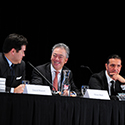Filter by
You must be a CTBUH Member to view this resource.
Al Maryah Tower
Al Hilal Bank Tower
Building
Completed, 2015
45005
office
concrete
Estidama 1 Pearl
120.0 m / 394 ft
24
9
1000
87,570 m² / 942,596 ft²
Usually involved in the front end design, with a "typical" condition being that of a leadership role through either Schematic Design or Design Development, and then a monitoring role through the CD and CA phases.
The Design Engineer is usually involved in the front end design, typically taking the leadership role in the Schematic Design and Design Development, and then a monitoring role through the CD and CA phases.
The Design Engineer is usually involved in the front end design, typically taking the leadership role in the Schematic Design and Design Development, and then a monitoring role through the CD and CA phases.
Other Consultant refers to other organizations which provided significant consultation services for a building project (e.g. wind consultants, environmental consultants, fire and life safety consultants, etc).
Material Supplier refers to organizations which supplied significant systems/materials for a building project (e.g. elevator suppliers, facade suppliers, etc).
You must be a CTBUH Member to view this resource.
Usually involved in the front end design, with a "typical" condition being that of a leadership role through either Schematic Design or Design Development, and then a monitoring role through the CD and CA phases.
The Design Engineer is usually involved in the front end design, typically taking the leadership role in the Schematic Design and Design Development, and then a monitoring role through the CD and CA phases.
The Design Engineer is usually involved in the front end design, typically taking the leadership role in the Schematic Design and Design Development, and then a monitoring role through the CD and CA phases.
The main contractor is the supervisory contractor of all construction work on a project, management of sub-contractors and vendors, etc. May be referred to as "Construction Manager," however, for consistency CTBUH uses the term "Main Contractor" exclusively.
Other Consultant refers to other organizations which provided significant consultation services for a building project (e.g. wind consultants, environmental consultants, fire and life safety consultants, etc).
Material Supplier refers to organizations which supplied significant systems/materials for a building project (e.g. elevator suppliers, facade suppliers, etc).
Best Tall Building Middle East & Africa 2015 Award of Excellence
2015 CTBUH Awards

09 March 2017 | Abu Dhabi
Building Maintenance Units Reach Great Lengths at Hilal Bank, UAE
Al Hilal Bank is a progressive Islamic bank headquartered in Abu Dhabi. It is an architectural accomplishment quite different from other buildings in Abu Dhabi....
The Al Maryah Tower is a flagship commercial development for the Al Hilal banking network. It is located on Abu Dhabi’s Al Maryah Island, situated at the midpoint between Abu Dhabi’s existing downtown district, Reem Island, and the new cultural district on Saadiyat Island. Al Maryah Island is a business, leisure, and entertainment hub designed to meet the city’s commercial and residential needs. This contemporary office tower is a key element for the district.
The project is well integrated into the city, with direct access to three primary island roads, and fulfills a need in the capital city for more office space. The scheme will be serviced by sophisticated transportation infrastructure, including a planned light rail station. The combination of the nearby P4 roadway and the corner articulation of the building anchor it to the site and give it a commanding sense of presence. The building’s design offers an original scheme shaped by a combination of the building’s function, site, and contextual influences. The tower’s composition features stacked boxes that are slightly offset from each other vertically so that it shifts in massing as it rises. Designed to set the building apart from other towers on Al Maryah Island while also providing efficient, column-free interior floor plates within, these forms derive their interest from a “push-and-pull” effect at the corners. In addition, the building’s façade changes composition at the created voids to accentuate this kinetic, shifted aesthetic.
The building incorporates a glass and steel curtain wall system which lends it a sleek, modern feel. Each façade includes exterior glass fins featuring a white ceramic frit pattern that provides texture. The fritted glass helps enhance the energy efficiency of the building by shading it from intense daylight while providing filtered light to the interior spaces. The façade has orange accents, which highlight the dynamic corners and call out the bank’s branding scheme. The trio of cubical masses rest upon a podium containing a retail banking facility as well as a dramatic three-story lobby to the north, with pedestrian arcades on the east and west sides. The glass curtain wall offers optimal transparency with floor-to-ceiling glass, creating a nearly seamless transition from the interior to the exterior of the structure. This experience is complemented by a plaza on the ground level. A landscaped park and reflecting pool along the building’s western elevation are intended to draw foot traffic to the main entryway and retail areas by creating an inviting, shaded urban space. Café seating for tenants and visitors helps to further energize this area.
Sustainable strategies include exterior shading, high performance glazing, and energy efficient components for lighting, heating, cooling, pumps, and fans, which all contribute to an energy savings of 12 percent. A comprehensive water strategy minimizes the project’s interior potable water consumption. Low-flow fixtures, metering faucets, and dual flush toilets are included for all common rest rooms. Condensate recovery is used to reduce water consumption for irrigation of the park. The site’s shrubs and trees have been selected based on minimal water requirements, and will provide additional shade. Extensive electrical metering provisions were installed at every level of energy distribution, accounting for all of the building’s electrical consumption and generation. All metering communicates with the Building Automation System, which identifies areas for further optimization.
Best Tall Building Middle East & Africa 2015 Award of Excellence
2015 CTBUH Awards

09 March 2017 | Abu Dhabi
Building Maintenance Units Reach Great Lengths at Hilal Bank, UAE
Al Hilal Bank is a progressive Islamic bank headquartered in Abu Dhabi. It is an architectural accomplishment quite different from other buildings in Abu Dhabi....

12 November 2015 | Abu Dhabi
Hiroo Mori, Director & Executive VP, Mori Building, Philip Nikandrov, Chief Architect, Gorproject, James Goettsch, CEO & Partner, Goettsch Partners, Jan Andersson, Senior Advisor, HSB...

12 November 2015 | Abu Dhabi
Interview: Al Hilal Bank Tower
James Goettsch, Chairman and CEO, Goettsch Partners, is interviewed by Chris Bentley regarding the Best Tall Building Featured Finalist, Al Hilal Bank Tower, Abu Dhabi,...

12 November 2015 | Abu Dhabi
Rethinking Office Space Through Creative Design: Al Hilal Bank Tower, Abu Dhabi
James Goettsch, CEO & Partner, Goettsch Partners, speaks at the 14th Annual Best Tall Building Symposium – Session 1 in a presentation entitled "Rethinking Office...
Subscribe below to receive periodic updates from CTBUH on the latest Tall Building and Urban news and CTBUH initiatives, including our monthly newsletter. Fields with a red asterisk (*) next to them are required.
View our privacy policy